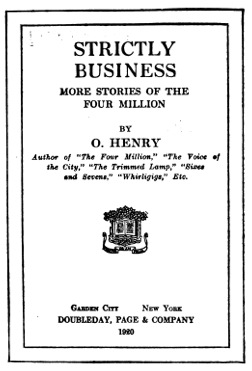For Sale: baby shoes, never worn
By Kevin Stein
Every story we read is an act of creation. The words on the page only tell us so much; it is our own hopes, our own fears, and our own memories of summer afternoons that illuminate the spaces which the stories leave dark. It is the nature of stories to be incomplete. And it is this incompleteness that can make stories so difficult for our students to enjoy.
At the end of last year, one of my students came to me with a list of phrases that she was having trouble understanding. They all came from the O. Henry story “A Ramble in Aphasia.” Like most O. Henry short stories, “A Ramble in Aphasia” has a knife twist of an ending. As I helped my student tease out the meaning of the phrases, she suddenly stopped and said, “He never lost his memory!” She grew silent, looked down at the book in front of her, and then looked up at me and said, “He is a real jerk!”

When we give our students a story, we are asking them to not only read, but to create. As they struggle to grasp the words on the page, it’s not surprising that sometimes they might confuse moments of not-understanding-what-is-written with moments of not-knowing-because-something-is-specifically-being-left-out. When I use short stories in my language classes, it’s my job to help students tell the difference and see those moments of not knowing for what they are, a chance to create meaning by working with the text.
I find that dramatic readings can help students recognize when they are being asked to bring something personal to a particular part of a story. Dramatic readings aren’t full-fledged plays, but are more kinesthetic than just reading out loud. In a dramatic reading activity, a story is split up and parceled out, each member of the group given responsibility for a different section of the text. Sometimes students break the text up by characters and than assign one or more students to play the role of narrator. Sometimes they simply divvy the text up by paragraphs. The students remain in their chairs and read the story out loud. As they practice reading the text three or four times, they begin to fill the words with the hues of emotion, just as they begin to fill the air around them with hand gestures small and large. They also begin to invest themselves into the parts of the story which had, perhaps only a little earlier, seemed empty of meaning.

The title of this post, “For Sale: baby shoes, never worn,” is often attributed to Earnest Hemingway and has been called the shortest novel in the English language. It’s a fine example of how plot — the points of a story a writer chooses to explicitly reveal to a reader — and story — everything that a reader and a text need to bring together to make meaning — can be very different things. The activity of time-lining a story can help students get more comfortable with the story/plot gap. First have students read a story. Then have them identify all the main events in the story and write them down on a blank time line. That is just the first step of the exercise. The real work comes in helping students include those parts of the story which have been left out. A time line of the plot points only of “baby shoes” would look something like this:

But how would your time-line of the full story look? What events would you chose to make explicit that are only hinted at in those six words. There’s a lot of space in this haiku of a novel. I doubt two people would fill it up in exactly the same way. For our students to enjoy reading a story, they might, at first, need help identifying just where those spaces exist. But once they do know, they can start to share how they fill in those spaces, and doing that is one of the great joys of talking about literature.
I believe that teaching my students how to ask for directions, answer a phone, write a resume, or draft a simple business letter are all important parts of my job. These skills will help my students survive day-to-day when they go to study abroad or find themselves in a situation where they need to use English on a regular basis. So I can understand why some teachers might be hesitant to use stories, especially difficult literary stories, in a language classroom. We only have a limited amount of classroom time and learning how to set a date for a business meeting probably seems more important that discussing why Edgar Allen Poe’s “Tell Tale Heart” is so creepy. But I would argue that this focus on the practical surface can obscure the underlying linguistic needs of our students.
All communicative interactions require us to deal with ambiguity. All texts, whether a business letter or a conversation with a friend, require us, at times, to read between the lines. And working with stories gives our students a chance to do exactly that. Great stories are filled with moments of silence. They are like the real world, rife with spaces waiting to be filled. When our students work with great stories, they are practicing one of the most important second language skills of all, how to take responsibility for not only understanding, but the act of meaning making when using the receptive skills. And without the awareness and courage build your own meaning in the dark corners of a text, no story, whether it be the simple recounting of a day or the laying out of an intricate five-year business plan, is ever truly complete.
A complete list of free O. Henry texts from Project Gutenburg is available here: http://www.gutenberg.org/ebooks/author/634?sort_order=title
Connect with Kevin and other iTDi Associates, Mentors, and Faculty by joining iTDi Community. Sign Up For A Free iTDI Account to create your profile and get immediate access to our social forums and trial lessons from our English For Teachers and Teacher Development Courses.


What a wonderful post Kevin! I’ve always loved using literature in class, but I feel next time I do I will be filled with inspiration and confidence thanks to this post. Often I think the enthusiasm of a teacher is infectious in these situations, so the class enjoy it more because you enjoy it. I feel the same about making space for creative writing in class as you do about reading stories, the idea of the ‘underlying linguistic needs’ is so important, as is equipping our students with the confidence and flexibility to read (write/speak/listen to) a wide range of texts.
I love the image of your students working on reading a story out loud. It is an activity that is often maligned but I can utterly see the merit here, especially in giving them the space to experiment in groups.
Funnily enough, I used the (alleged) Hemingway story in a recent post on ‘very short stories’ (http://creativitiesefl.wordpress.com/2013/02/19/very-short-stories/) – Great minds think alike?! I love your idea of filling in the ‘gaps’ of this story.
Thanks again for the great post!
Hi Jo,
Thanks for the lovely comment. I was a little worried that the post had gotten a bit too esoteric, so it’s good to know it had something that you could pick up and see using in your classroom.
I don’t know how I managed to miss your post on “Baby Shoes” and six word memoirs in general. It’s a great post and I’ll be using 6 word memoirs in class sometime soon. Haiku’s, flash fiction, Twitter stories, and 6 word memoirs are all rich texts to use in a language class. I have some friends who assure me that poetry in general is great in a language class for the same reasons I’ve touched on in this post.
I agree that a teacher’s passion for certain materials can be infectious. Whether it be music, reading stories, writing creative texts, if the teacher is engaged and working with the materials themselves, they can be a real role model for the students.
I’d love to start up a list of literature(-ish) materials teachers are using in class. If anyone has some other sites or stories or poems to suggest, please leave them as a comment and let’s see where things go…
Kevin
I don’t know why this made me react so emotionally. The tenderness of your practice, your voice. I couldn’t help but think, “what if politicians thought this way?” People fill in the gaps whether they know it or not – but to recognize that this is the project and to become more intimate with ourselves by becoming more intimate with the text, the story, the situations – it is a precious gift, an opportunity that often requires a teacher’s illumination: “Here it is. It asks for you. What do you see? Is it you or the text – or both?” Thank you for these thoughts.
Barry,
Thanks for taking the time to comment. I think you’ve taken what I wrote and framed it beautifully. It certainly would be a fine thing if politicians used rhetoric not for obfuscation, but to provide a space for something to be created between speaker and listener, writer and reader. But that might be expecting too much. As it is, we have great stories, and teachers like you, who believe in the power of the stories to bring us closer to ourselves and others. Thanks for sharing your thoughts and letting me know this post had some part in helping them find their way into the world.
Kevin
Great post, it made me realize why I’ve been doing some of the things I was doing or telling my students in our Japanese literature in English class– especially that part about how we need to let the students know that there’s a difference between points in a story where they don’t understand what’s written, and the other places where they’re not supposed to understand a certain thing, but imagine, and fill in the gaps by themselves. Also, I wish I knew about Hemingway’s haiku-novel when I taught story and plot…
Thank you!
Hi Irina,
Thanks for taking the time to comment. A Japanese literature in English class sounds amazing. I’ve used a few Yasunari Kawabata “Palm of the Hand” stories in my classes. They are short and the language is relatively simple. Best of all, it’s easy for the students to access the stories in Japanese, so when they feel lost, they can check their comprehension on their own. I would love to hear more about your class and the texts you are using.
“Baby Shoes” is a pretty heavy 6 word story and might be a little removed from our students’ personal experience. Jo made reference to 6 word memoirs above and there are many short texts on the Smith site and they even have a page for teens (http://www.smithteens.com/) which might be more appropriate.
Thanks again for your feedback and sharing a bit about your class.
Kevin